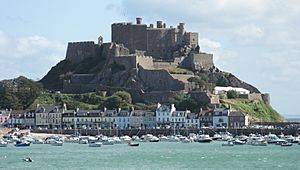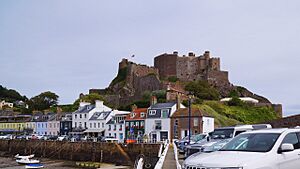Mont Orgueil facts for kids
Quick facts for kids Mont Orgueil |
|
|---|---|
| Gorey Castle | |
| St Martin, Jersey | |

Mount Orgueil from the south
|
|

Second World War German range-finding positions were installed into the existing structure to resemble medieval features in order to avoid detection by Allied reconnaissance.
|
|
| Coordinates | 49°11′58″N 2°01′10″W / 49.1994°N 2.0194°W |
| Site information | |
| Owner | People of Jersey |
| Controlled by | Jersey Heritage Trust |
| Open to the public |
Yes |
| Condition | Intact |
| Site history | |
| Built | 1204–1450 |
| In use | 1204–1945 |
| Materials | Granite |
Mont Orgueil is a famous castle in Jersey. It means 'Mount Pride' in French. The castle looks over the harbour of Gorey, a port on the east coast of the island. Many English-speakers call it Gorey Castle. People who speak Jèrriais, the local language, call it the "Old Castle" (lé Vièr Châté).
The castle was first called 'Mont Orgueil' in 1462 when the French controlled it. For hundreds of years, it was the main fortress and a symbol of royal power in Jersey. It kept this role until Elizabeth Castle was built in 1594. Today, Mont Orgueil is a Grade I listed building, meaning it's a very important historical site.
Contents
Ancient History of the Castle Site
In the 1970s, archaeologists dug at the castle site. They found proof that people had fortified this spot during the Iron Age. This was a time when people used iron tools and weapons. They built an earth wall at the top of the granite rock where the castle now stands.
Other items were also found, like arrowheads and pottery. These date back to the Neolithic period, which was from about 4000 to 2500 BC. This shows that people lived and worked here long before the castle was built. These early forts were common in northern Jersey. They used high cliffs for natural protection against attackers.
Medieval Times
Jersey became part of the Duchy of Normandy in 933. This happened when the French king gave the islands to the Normans. Later, in 1204, the islands became part of the Kingdom of England. This was after King Philip II of France took Normandy from King John.
Mont Orgueil Castle was built after this change. It was first mentioned in records in 1212. For over 400 years, it was Jersey's main defense. It survived many French attacks. One famous attack was in July 1373. The French Constable, Bertrand du Guesclin, attacked with 2,000 men. The French broke through the outer walls. However, they could not get past the inner walls. These inner walls were built on solid granite rock, making them very strong.
The castle was finally captured by French forces in May 1461. This was part of a plan by Margaret of Anjou, the wife of King Henry VI of England. She was trying to get French military help during the Wars of the Roses. A secret gate was left open for the French. The English soldiers inside had been given alcohol. This suggests that the castle's leader, Sir John Nanfan, who supported Margaret, was involved in the betrayal.
The French kept control of Jersey until 1468. Then, an English and Jerseyman force, led by Admiral Richard Harliston, took it back. During this time of French rule, the castle became known as 'Mont Orgueil Castle'. Before that, it was usually called 'Gorey Castle'.
Changes in the 1500s
In the mid-1500s, Mont Orgueil went through big changes. This was because cannons were becoming more common in wars. The castle was at risk from cannon fire coming from a nearby hill. This hill was called Mont St Nicolas.
The castle was updated to handle artillery. For example, the battlements were made lower. This allowed cannons to fire over the walls. The walkways on the battlements were also made wider. These changes were started by Henry Cornish. He was an officer working for the Earl of Hertford. Cornish even complained that earlier repairs had made parts of the castle too weak.
Later updates included making the medieval Keep stronger. It was turned into a D-shaped bastion in 1551. A large L-shaped battery, called the Grand Battery, was also built around 1560. It faced west. However, these efforts were not enough. Mont Orgueil was soon replaced by Elizabeth Castle. This new castle was built on a small island near St Helier in 1594. Walter Raleigh, who was Governor of Jersey in 1600, stopped a plan to tear down Mont Orgueil. He said it would be "a pity to cast it down."
The 1600s: Prison and War
For a long time, Mont Orgueil was Jersey's only prison. This lasted until a new prison was built in St Helier in the late 1600s. The English government found it useful to send people who caused trouble to Mont Orgueil. This included people like William Prynne and John Lilburne. Jersey had different laws from England, which made it easier to hold prisoners there. Some men who had been involved in the execution of King Charles I were also sent to Mont Orgueil in 1661.
During the English Civil War, the island's leader, Sir Philippe de Carteret, supported the Royalists. He held Elizabeth Castle for the King. His wife, Anne de Carteret, and their son stayed at Mont Orgueil. From Mont Orgueil, the Royalists took back the island from the Parliamentarian forces in November 1643.
Two men, David Bandinel and his son Jacques, were imprisoned at the castle. They had supported the anti-Royalist side. In February 1645, they tried to escape by climbing out of a window on the sea side. Their makeshift rope broke, and they fell to their deaths on the rocks below.
In December 1651, an army called the New Model Army invaded Jersey. They were led by Colonel James Heane. His 3,000 soldiers defeated the Jersey militia. Faced with a strong army, Mont Orgueil Castle surrendered. The soldiers inside were allowed to go to Elizabeth Castle.
By 1691, a report said the castle's living quarters were falling apart. Two years later, the castle was in ruins. It was no longer used as a prison because Elizabeth Castle was now built.
Later Years and Today
Some repairs were done to Mont Orgueil between 1730 and 1734. For the rest of that century, parts of the castle were used to house soldiers. In 1770, officers and soldiers lived in the rooms inside the Keep. The old Catholic chapel, St Mary's Chapel, was even turned into a barrack room for 60 men.
The castle was later given to a British naval officer, Philippe d'Auvergne. He led a spy network called 'La Correspondance'. This group worked to cause problems for the French government in France. One plan involved bringing fake French money into the country. In 1800, a tower in the castle was set up as d'Auvergne's private headquarters.
Throughout the 1800s, groups of soldiers continued to live in the castle.
Until the late 1800s, the castle was open to the public only once a year, on Easter Monday. Crowds would come from all over the island to visit. This tradition might have come from an older custom of visiting St George's Chapel inside the castle on St George's Day.
The castle continued to fall into disrepair. Because it was in such a ruined state, the Crown gave it to the people of Jersey on June 28, 1907. Since 1929, Mont Orgueil has been managed as a museum.
During the Second World War (1940–1945), German forces occupied the castle. At first, only a small guard was placed there. But in 1941, more troops moved in. The Germans wanted to turn the Channel Islands into a strong fortress. Soldiers from the Army Coastal Artillery Regiment 1265 used the observation towers. A small group of German infantry also stayed there. In July 1944, a temporary bunker was built inside the castle. It became the headquarters for a German artillery battalion.
Royal Visits to the Castle
In 1846, Queen Victoria and Prince Albert visited the castle. Later, King George V visited in 1921. Queen Elizabeth II also visited. Special inscriptions mark these important royal occasions.
Mont Orgueil Today
The Jersey Heritage Trust has managed this historic site since 1994. In the early 2000s, the Trust planned to build a Tudor hall inside the castle's keep. Around the same time, a grant of £3 million was given for restoration work.
In 2004, a special Jersey pound note was released. It showed Mont Orgueil on it. The castle is also featured on the Jersey 50-pound note from 2010. On April 2, 2006, after a long building project, the castle reopened to the public. The Lieutenant-Governor of Jersey officially reopened it.
The restoration work has opened up parts of the castle that visitors could not see before. New modern additions have made some areas weatherproof. Parts of the castle's history have been explained in new ways. Art displays and features in the castle grounds now offer more attractions for visitors.
See also
 In Spanish: Mont Orgueil para niños
In Spanish: Mont Orgueil para niños



